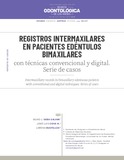Mostrar el registro sencillo del ítem
Registros intermaxilares en pacientes edéntulos bimaxilares con técnicas convencional y digital. Serie de casos
| dc.rights.license | http://creativecommons.org/licenses/by-nc-sa/3.0/ve/ | es_VE |
| dc.contributor.author | Saba Salami, Silvio | |
| dc.contributor.author | Cova N., José Luis | |
| dc.contributor.author | Bustillos R., Lorena | |
| dc.date.accessioned | 2022-08-10T16:44:51Z | |
| dc.date.available | 2022-08-10T16:44:51Z | |
| dc.date.issued | 2022-08-10 | |
| dc.identifier.issn | 1856-3201 | es |
| dc.identifier.uri | http://www.saber.ula.ve/handle/123456789/48371 | |
| dc.description.abstract | En la rehabilitación protésica del paciente edéntulo bimaxilar la toma de registros de las relaciones intermaxilares determina una etapa crítica en el éxito del tratamiento e influye en la estética y en el funcionamiento de las prótesis totales. Para obtener los registros intermaxilares, habitualmente se emplean rodetes de cera para mordida (Técnica Convencional), y para las prótesis totales elaboradas con tecnología CAD-CAM, los registros intermaxilares son obtenidos con cubetas equipadas con un trazador intrabucal (Técnica Digital). El objetivo fue comparar las técnicas convencional y digital en la toma de registros intermaxilares mediante el análisis cefalométrico de Ricketts. El estudio es una serie de casos, conformado por cinco pacientes totalmente edéntulos con edades comprendidas entre 61 y 90 años. A cada paciente se le realizaron dos registros intermaxilares, uno para técnica convencional y otro para técnica digital, acompañado de una radiografía cefálica lateral con cada uno de los registros colocados en la cavidad bucal, para obtener la Altura Facial Inferior y la Convexidad Facial de Ricketts. Los resultados obtenidos mostraron que hay poca variación entre los métodos empleados. La media de Convexidad Facial fue de -0.4 mm ± 2.88 en la Técnica Convencional y de -1.0 mm ± 2.55 en la Técnica Digital, mientras la media de AFI fue de 41.6° ± 4.45 en la Técnica Convencional y de 41.4° ± 5.59 en la Técnica Digital, por lo que ambas se pueden usar de forma confiable en el tratamiento de rehabilitación protésica de estos pacientes. | es_VE |
| dc.language.iso | es | es_VE |
| dc.rights | info:eu-repo/semantics/openAccess | es_VE |
| dc.subject | dimensión vertical | es_VE |
| dc.subject | cefalometría | es_VE |
| dc.subject | diseño asistido por computador | es_VE |
| dc.subject | boca edéntula | es_VE |
| dc.subject | prótesis e implantes | es_VE |
| dc.title | Registros intermaxilares en pacientes edéntulos bimaxilares con técnicas convencional y digital. Serie de casos | es_VE |
| dc.title.alternative | Intermaxillary records in bimaxillary edentuous patients with conventional and digital techniques. Series of cases | es_VE |
| dc.type | info:eu-repo/semantics/article | es_VE |
| dcterms.dateAccepted | 02/11/2019 | |
| dcterms.dateSubmitted | 05/05/2019 | es |
| dc.description.abstract1 | In prosthetic rehabilitation of the bimaxillary edentulous patient, the recording of intermaxillary relationships determines a critical stage in the success of the treatment and influences the aesthetics and functioning of total prostheses. To obtain the intermaxillary records, bite wax rims are usually used (conventional TC technique), and for total prostheses made with CAD-CAM technology the intermaxillary records are obtained with trays equipped with an intrabuccal tracer (TD digital technique). The objective of this research is to compare conventional and digital techniques in the taking of intermaxillary records by means of Ricketts’ cephalometric analysis. The study is a series of cases, consisting of five totally edentulous patients aged between 61 and 90 years. Two intermaxillary records were made for each patient, one for conventional technique and another for digital technique, accompanied by a lateral cephalic radiography with each one of the registers placed in the buccal cavity, to obtain the lower facial height (AFI) and the facial convexity (CF) of Ricketts. The results obtained showed that there is little variation between the methods used. The mean CF was -0.4 mm ± 2.88 on the CT and -1.0 mm ± 2.55 on the TD, while the mean of AFI was 41.6 ° ± 4.45 on the CT and of 41.4 ° ± 5.59 on the TD, by which both can be used reliably in the dental practice. | es_VE |
| dc.description.colacion | 124-137 | es_VE |
| dc.description.email | silviojsaba@gmail.com | es_VE |
| dc.description.email | cona@ula.ve | es_VE |
| dc.description.email | bustillo@ula.ve | es_VE |
| dc.description.frecuencia | Semestral | es |
| dc.description.paginaweb | http://erevistas.saber.ula.ve/odontoula | es |
| dc.identifier.depositolegal | pp-200502ME2052 | es |
| dc.publisher.pais | Venezuela | es_VE |
| dc.subject.facultad | Facultad de Odontología | es_VE |
| dc.subject.institucion | Universidad de Los Andes | es_VE |
| dc.subject.keywords | vertical dimension | es_VE |
| dc.subject.keywords | cephalometry | es_VE |
| dc.subject.keywords | computer-aided design | es_VE |
| dc.subject.keywords | mouth | es_VE |
| dc.subject.keywords | edentulous | es_VE |
| dc.subject.keywords | prostheses and implants | es_VE |
| dc.subject.seccion | Revista Odontológica de Los Andes: Reporte de Caso | es_VE |
| dc.subject.tipo | Revistas | es_VE |
| dc.type.media | Texto | es_VE |
Ficheros en el ítem
Este ítem aparece en la(s) siguiente(s) colección(ones)
-
Revista Odontológica de Los Andes - Vol. 015 - Nº 1
Enero - Junio 2020


